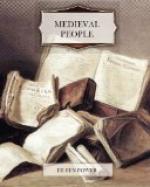6. Quoted in Lipson, Introd. to the Econ. Hist, of England (1905), I, p. 421.
7. Quoted ibid., p. 417.
8. On John Winchcomb see Power, op. cit., pp. 17-18; and Lipson, op. cit., p. 419.
9. Deloney’s Works, ed. F.C. Mann, pp. 20-1.
10. Ibid., p. 22.
11. Quoted in C.L. Powell, Eng. Domestic Relations, 1487-1563 (1917), p. 27.
12. The house subsequently passed, it is not quite clear at what date, into the hands of another family of clothiers, the Buxtons, who had intermarried with the Paycockes some time before 1537. William Buxton (d. 1625) describes himself as ‘clothyer of Coggeshall’ and leaves ‘all my Baey Lombs [Looms]’ to his son Thomas. Thomas was seventeen when his father died and lived until 1647, also carrying on business as a clothier, and the house was certainly in his possession. He or his father may have bought it from John Paycocke’s executors. By him it was handed down to his son Thomas, also a clothier (d. 1713), who passed it on to his son Isaac, clothier (d. 1732). Isaac’s two eldest sons were clothiers likewise, but soon after their father’s death they retired from business. He apparently allowed his third son, John, to occupy the house as his tenant, and John was still living there in 1740. But Isaac had left the house by will in 1732 to his youngest son, Samuel, and Samuel, dying in 1737, left it to his brother Charles, the fourth son of Isaac. Charles never lived in it, because he spent most of his life in the pursuit of his business as an oil merchant in London, though he is buried among his ancestors in Coggeshall Church. In 1746 he sold the house to Robert Ludgater and it passed completely out of the Paycocke-Buxton connexion, and in the course of time fell upon evil days and was turned into two cottages, the beautiful ceilings being plastered over. It was on the verge of being destroyed some years ago when it was bought and restored to its present fine condition by Mr Noel Buxton, a direct lineal descendant of the Charles Buxton who sold it. See Power, op. cit., pp. 38-40.
13. Deloney’s Works, ed. F.O. Mann, p. 213.
14. Defoe, Tour through Great Britain, 1724 (1769 edit.), pp. 144-6.
15. ’This shire is the most fatt, frutefull and full of profitable thinges, exceeding (as far as I can finde) anie other shire for the general commodities and the plentie, thowgh Suffolk be more highlie comended by some (wherewith I am not yet acquainted). But this shire seemeth to me to deserve the title of the Englishe Goshen, the fattest of the lande, comparable to Palestina, that flowed with milk and hunnye.’—Norden, Description of Essex (1594), (Camden Soc.), p. 7.
16. According to Leake, writing about 1577, ’About 1528 began the first spinning on the distaffe and making of Coxall clothes.... These Coxall clothes weare first taught by one Bonvise, an Italian.’—Quoted V.C.H. Essex, II, p. 382.




